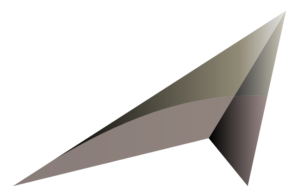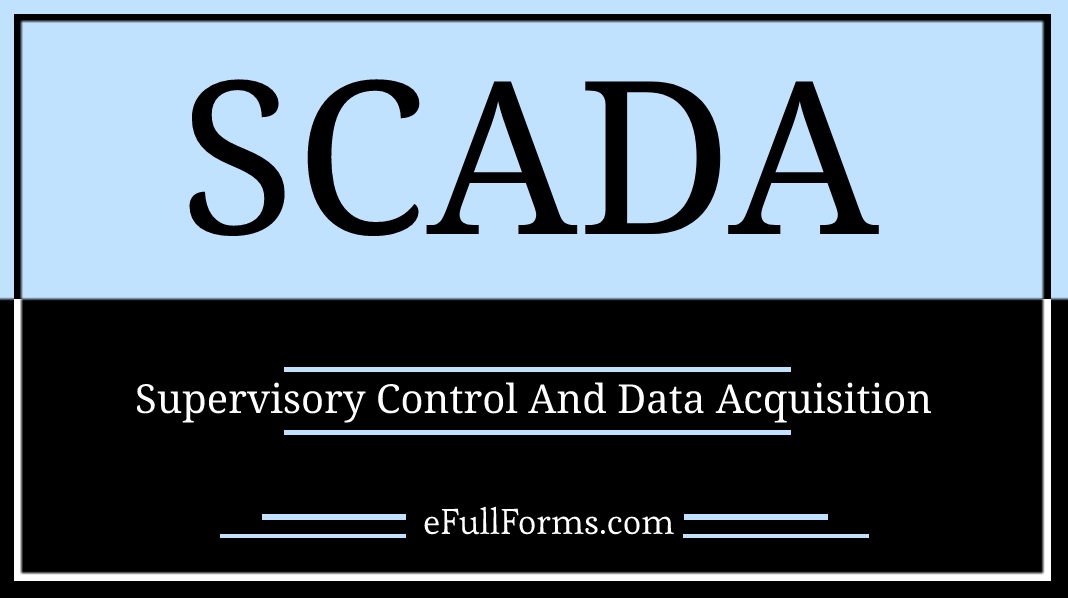SCADA Full Form: What Does SCADA Stand For?
Do you want to know what is full form of SCADA is? Then, here you will come to know what Does SCADA stand for? Also all possible Full Form of SCADA.
Table of Contents
SCADA Full Form
The term SCADA has many full forms, but out of which most relevant full form is-
SCADA Full Form is – Supervisory Control And Data Acquisition
The term SCADA (Supervisory Control and Data Acquisition) defines systems used in industry and transport that continuously collect data from sensors controlling the processes, send them to the control centre for processing, and provide dispatching personnel to make the necessary decisions implementing control actions. It can be used to define the class of application software used to solve problems of this type in a narrower sense.
We face the simplest tasks of dispatch control and management even at home, manipulating the illumination of the premises or filling the bathroom for bathing. We still often cope with such tasks ourselves, although the concept of a “smart home” has existed for a long time. But suppose the number of conventional bulbs begins to count in the thousands. In that case, they turn out to be scattered over a large area, pours into the bathtubs at once from several taps and at the same time completely different from what was poured out; you have to use SCADA systems.
SCADA systems appeared long before creating and distributing modern digital data transmission systems and were originally based on their specialized solutions and architectures. SCADA systems are currently evolving towards modern open standards. This allows them to use new capabilities of modern means and technologies of communication.
SCSDA systems built based on computer technology evolve with them. From this point of view, we can talk about three generations of SCADA systems.
The first automated control systems for industrial processes were created in the era of single mainframes before the advent of networks. Such systems were stand-alone and designed for the management of separate industries.
Remote RTUs have been developed and widely used to service objects and groups of objects located at long distances. Communication with them was realized through the existing telecommunication channels, and the protocols for data exchange had to be developed by the RTU manufacturers themselves. These protocols were the developer’s intellectual property and had little in common with those used in today’s public wide area networks. Initially focused on transmitting relatively small information streams, they had no reserves to increase the speed of work and the means for parallel transmission of other types of data.
Hardware solutions were also not very versatile. The high-reliability requirements were provided in the first-generation systems by hardware redundancy with continuous monitoring by the backup instance of the operation of the primary system instance.
What is the History of SCADA?
The term Supervisory Control And Data Acquisition System, or SCADA system, appeared in the late 1980s. XX century. Simultaneously with the first attempts to use personal computers with graphical applications installed on them as operator consoles.
The first SCADA systems were developed for DOS or Unix operating systems. They had rather modest capabilities, both due to hardware limitations of the hardware and the graphical capabilities of operating systems. SCADA systems became widespread simultaneously with the appearance of graphical interfaces, such as Windows 3.11, X-Windows, Phantom, and hardware that allows you to achieve the required speed of execution of processes in multitasking modes.
The emergence of SCADA systems as tools for the development of top-level software is similar to the reasons for the emergence of systems such as Borland Delphi and other visual programming systems. Their main task is to relieve software developers of the routine and, in fact, the useless burden of describing standard interfaces and functions. At the same time, it should be understood that the use of SCADA systems does not imply a reduction in the requirements for the level of developer’s qualifications, as they try to imagine.
The second generation of SCADA systems owes its appearance to the proliferation of compact computers and local area network technologies.
This made it possible to distribute the control functions among several relatively small computers. In addition, this made it possible to introduce functional differentiation between them: to single out individual machines or groups of machines for collecting information, processing data, storing data and ensuring interaction with personnel.
The use of a LAN limited the size of such systems.
Since SCADA requires a real-time operation, this requirement was imposed on LAN protocols as well.
Often it was convenient for developers to create special protocols for this or modify existing ones. As a result, they and network equipment turned out to be incompatible with the existing ones on the market.
The move to distributed systems has changed the approach to providing fault tolerance. Now there is no need to keep a redundant backup system ready. With the simultaneous operation of several network nodes, if one of them fails, the remaining ones can immediately distribute its functions among themselves (in the presence of some redundancy but without complete duplication).
However, the connection to the RTU system was carried out, as in the first generation systems, with specialized slow technologies and protocols. This left the user permanently attached to the manufacturer of the equipment of his choice.
Modern SCADA systems are usually referred to as the third generation. While retaining the basic elements of the third generation systems (multiple control nodes with the distribution of functions and RTUs), the third generation systems are gradually phasing out the closed protocols of equipment manufacturers and moving to generally accepted open network protocols. This also applies to the technologies of the organization.
What Does SCADA Stand For?
SCADA stands for – Supervisory Control And Data Acquisition
What is Full Forms of SCADA
Now, here is the complete Full-Form list of the term SCADA.
| Sr. No. | Term | Category | SCADA Full Form |
|---|---|---|---|
| 1 | SCADA | Information Technology | Supervisory Control And Data Acquisition |
| 2 | SCADA | Technology | Satellite Collection and Data Access |
| 3 | SCADA | Technology | Security Control and Data Acquisition |
| 5 | SCADA | Educational | Sequential Control and Data Aquisition |
| 6 | SCADA | Information Technology | Sound Communication And Data Acquisition |
| 9 | SCADA | Associations | South Carolina Automobile Dealers Association |
| 10 | SCADA | Local | Southern California Americans for Democratic Action |
| 11 | SCADA | Information Technology | Speakerbuilders Computer Aided Design and Analysis tool |
| 12 | SCADA | Professional Organizations | State of California Auto Dismantlers Association |
| 13 | SCADA | Automotive | State of California Automotive Dismantlers Association |
| 14 | SCADA | Professional Organizations | Student Clinicians of the American Dental Association |
| 15 | SCADA | Service | Supervisory Control and Data Access |
| 16 | SCADA | Technology | Supervisory Control and Data Acquisition System |
| 17 | SCADA | Technology | Supervisory Control And Data Acquisition Telemetry |
| 18 | SCADA | Technology | Supervisory Control and Data Analysis |
| 19 | SCADA | Information Technology | Supervisory Control And Data Aquisition |
| 20 | SCADA | Educational | Supervisory, Control, and Data Acquisition |
| 21 | SCADA | Technology | Surveillance Control and Data Acquisition |
| 22 | SCADA | Biosensor | System And Data Acquisition |
| 23 | SCADA | Technology | System Control and Data Acquisition |
| 24 | SCADA | Technology | Subsea Control and Data Acquisition |
FAQ’s
What is the Meaning of SCADA?
SCADA Means – Supervisory Control And Data Acquisition
What is SCADA Full Form in Electrical?
Supervisory Control And Data Acquisition
What is SCADA Full Form in Civil Engineering?
SCADA Full Form is – Supervisory Control And Data Acquisition
Final Words: I hope you get what you want to know about SCADA. If you want to know the full forms of other term, then please ask by comments or email. Your valuable comments are always welcome.



